How to Hire SWE Interns at a Tech Startup
How we recruited three talented software engineering interns for our tech startup for summer 2022. Here's my tips for other entrepreneurs considering summer internships.
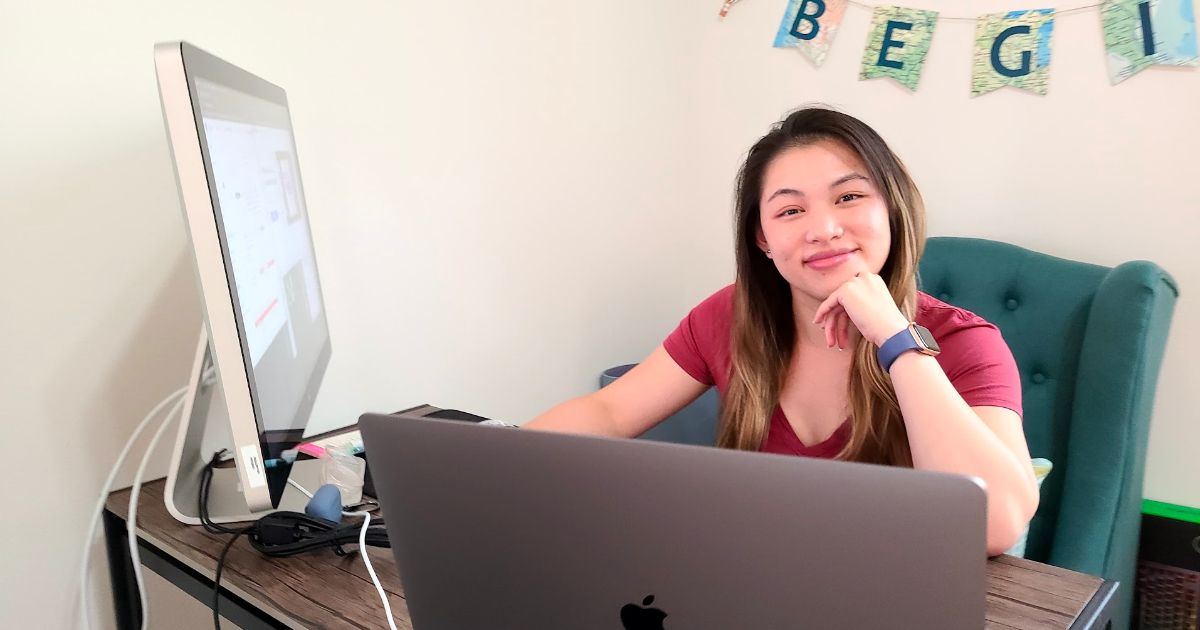
We just wrapped up the 2022 summer internship recruiting here at Kapwing, a Series A startup based in San Francisco. In some ways, the hiring process for software engineering interns is a microcosm for engineering recruiting more broadly. Intern hiring put our interview system to the test, exposed the weaknesses and strengths of our hiring funnel, cost a lot of engineering hours, and led to three great intern hires for 2022.
In this article, I’ll explain how we hired our summer interns and share some of my learnings about intern hiring for other entrepreneurs.
Note: If you're a SWE intern planning to intern at a startup in Summer 2022, read our guide to succeeding in your internship.
The Water Hose: Sourcing
On August 11, I posted a pretty basic full-stack engineering internship position on our careers page and Handshake profile. Between 11/11 and the end of the year, we received more than 1500 inbound applications for our 2022 SWE Internship position.
The volume and quality was shocking given that we’ve barely gotten a dozen qualified applicants for our main full-time SWE role this year. Our tiny recruiting team was both thrilled and completely overwhelmed to see so many fantastic engineering candidates putting their name in our hat. We got hundreds of applications from juniors at Harvard, Stanford, MIT, CMU, and other top CS programs and from students who had interned at Facebook, Google, Stripe, Coinbase, and many other high tech companies previously. Eventually, we had to shut the application portal to referrals only to reduce the volume.
Most of the candidates who applied said they heard about Kapwing on our careers website or through a job board like Handshake, LinkedIn, or Indeed. Some cited various other websites, including Simplify, CSCareers.Dev, and this popular Pitt CSC directory on Github. We also got a few referrals from our team.
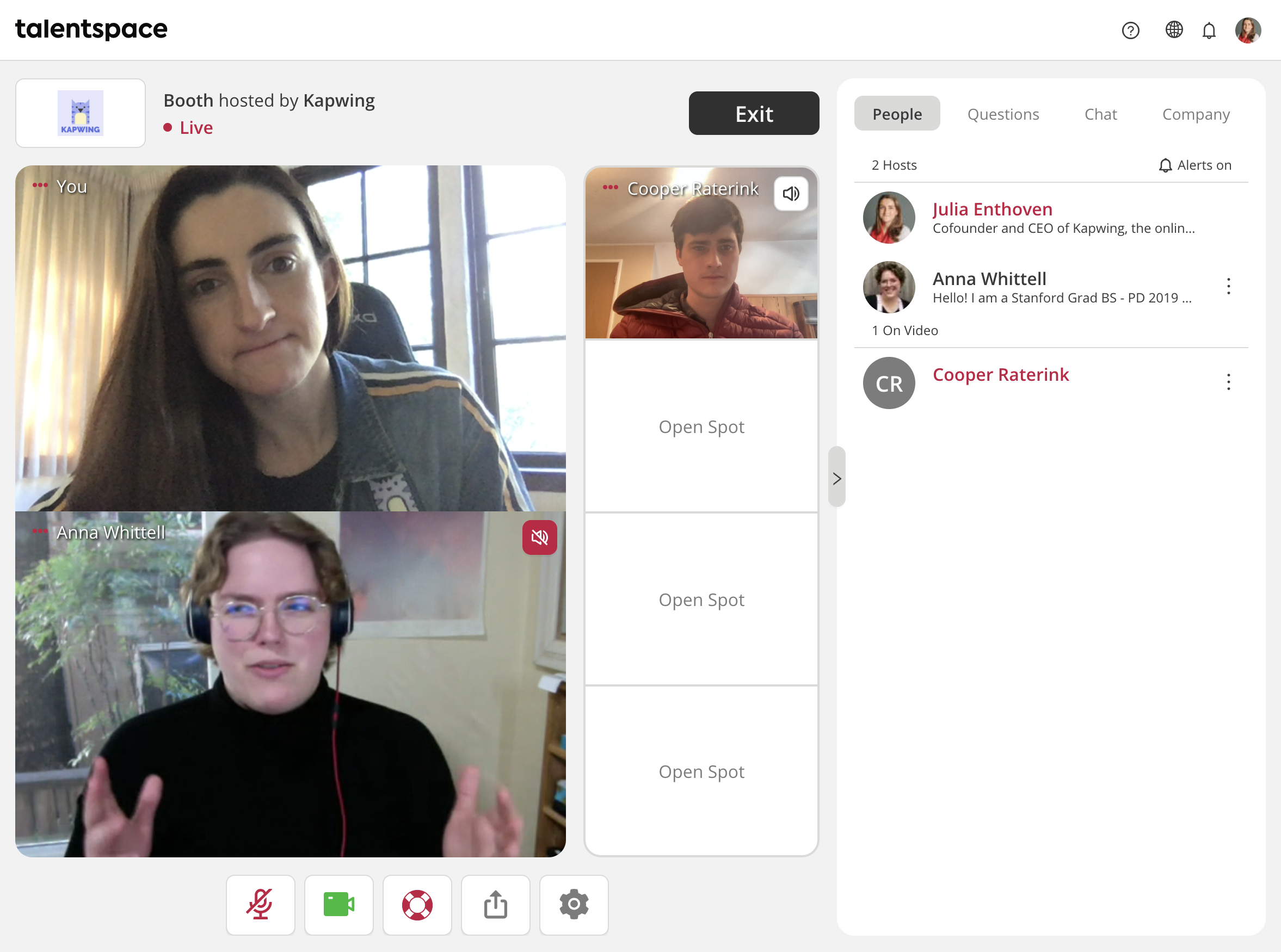
If you want to recruit good interns for your startup, here’s what we did right to get so many qualified applicants:
- Timing: FAANG recruits in the late summer, and we didn’t want to miss out on exposure to qualified engineering students. Even August 11 was late for candidates who needed to make a decision on a return offer within a week or two of finishing their 2021 internship.
- Internship season flexibility: We put up a posting for a Spring Internship in addition to a standard Summer Internship. This attracted a lot of candidates, maybe because it stands out from companies that only do summer internships. There are many CS programs that encourage six-month internships or co-ops, so there’s a high volume of engineers looking for something longer-term than a 12-week gig.
- Job Boards: We listed the job posting on both our website and on Handshake, an amazing free job board for reaching college students. We’ve hired excellent engineers in the past off of Handshake; I’m going to regret sharing this here because it’s our most valuable hiring secret.
- Content Marketing: Like our full-time candidates, intern candidates sometimes cited our Instagram, YouTube channel, and our company blog as places where they learned more about company culture.
We also made mistakes in sourcing. For example, all 7 of the candidates who received Kapwing internship offers were white or Asian men. We got many worthy applications from women and other underrepresented groups, but, because we didn’t have systems to prioritize them, many fell through the cracks and never got a call. In the future, we want to set up systems to give more under-represented candidates a chance to interview. We will also promote the internship on job boards and communities that value diversity.
Many of our intern candidates had used Kapwing before, and most of the applicants could relate to our mission. At the very least, the internship application was a great advertisement for Kapwing that reached thousands of high-potential creators.
Before this year, we had only talked to candidates referred directly by our team. That’s how we found Derrick, our 2021 intern, and our 2018 intern. That process was simple and quick, since we evaluated just a couple of candidates and had positive signal to start with. This year, in contrast, our intern recruiting process was slow, rigorous, and expensive because of the huge number of candidates. But as a result of the hard work, we managed to hire three fantastic interns, and summer 2022 will be the first time we’ve had multiple interns at once. Since it was open to students across the country, this year’s process was also more equitable, honoring our startup’s commitment to inclusion.
Screening
What does a startup do with thousands of applications? We really struggled to screen them and separate the gems from the noise. Normally, it’s easy to spend 10-20 minutes each day screening in-bound candidates, and I split this responsibility with our engineering managers. For the interns, this was impossible. Too many short resumes.
Ultimately, we talked to a small fraction of the inbound candidates (<100 students), and there were a lot of stellar candidates who we never connected with. Although it was tragic and frustrating to turn away talent, we didn’t have the bandwidth to talk to everyone while also growing our business and serving customers. Maybe we can keep in touch with these impressive engineering students and reach out to them later as they get more experience.
Here’s some learnings about screening resumes:
- Automation is essential. Lever, our ATS which is generally a good product, does not have good screening tools built in. For example, we wanted to reject candidates who were not authorized to work in the USA without sponsorship as we’re not able to sponsor H1Bs yet. But you have to pay Lever extra for a system to filter or reject by candidates who did not have work authorization. This was a huge headache and caused me and our recruiting coordinator dozens of hours manually rejecting candidates. Soon, we will upgrade our Lever account for automations....
- Supplemental questions can help you probe for candidates who are truly interested in your company vs “spray and pray” candidates that are applying to countless other companies. Engineers with authentic interest in your product are much more likely to complete the interview process and accept an offer than those who don’t take the time to respond to “Why do you want to work here?”
- Know your deal-breakers. We rejected candidates who had never built a production-level website before. I trained our office manager and People Ops Lead to screen out and archive underqualified candidates.
- Many startups set up a pre-screen challenge that a candidate can take without any work from your engineering team. This gives candidates a chance to prove their skills and scales to hundreds of candidates. One of our new-grad engineers commented that “for new grad job listings + internships, 90% of their first steps are hackerrank/leetcodes.” We may look into this next year as it’s more fair than subjectively choosing resumes.
Content made on Kapwing
We do not screen out underclassmen, although many companies do. This year, we got some applications from really impressive college sophomores and freshman. When one of our current engineers referred a sophomore, David, for the internship, we decided to interview him and ended up hiring him. Derrick, our full-year intern in 2021, is a college sophomore but made contributions similar to a mid-level engineer. You likely won’t be able to bring on a sophomore full/time for two years, but if you give them a chance you may be able to find some 10x gems.
In December, we ended up screening out sophomores as a tool to wade through the mass of applications, but I’m not sure this was the best decision. TBD if we will do this next year.
Interviewing
At Kapwing, we interviewed interns exactly like we interview full-time engineers. Interviewing interns took a lot of time, but also showed that our engineering interview process is robust and leads to solid outcomes.
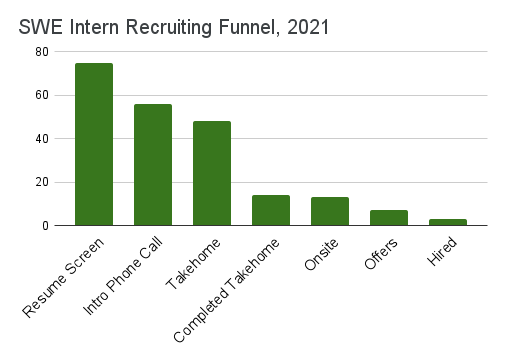
Here’s the data about our internship recruiting funnel:
- 1480 applications
- Reached out to 74 candidates for intro phone calls
- Scheduled and conducted phone screens with 56 candidates
- Gave 48 candidates our take-home project
- 15 candidates completed the take-home project
- 13 candidates did our “virtual onsite”
- Made 7 internship offers
- 3 fantastic candidates accepted summer internship offers
This funnel looks similar to the funnel for our full-stack engineering role with a few differences:
Only 28.5% of candidates finished our takehome project, which is a bit lower than the 34% of full-time engineers who are able to complete it. I think that this can be anticipated since interns tend to be less experienced and busier handling multiple takehome projects at once for many different internship interviews. ~30% of candidates who passed the phone screen withdrew because they had received other offers while they were working on the Kapwing takehome, indicating that our interview process may be too long.
We actually had a higher bar for interns than our entry-level new grads because interns have to be able to jump in to make the summer worthwhile. We interviewed for coachability and for enough domain familiarity that they could make an impact in a short time frame.
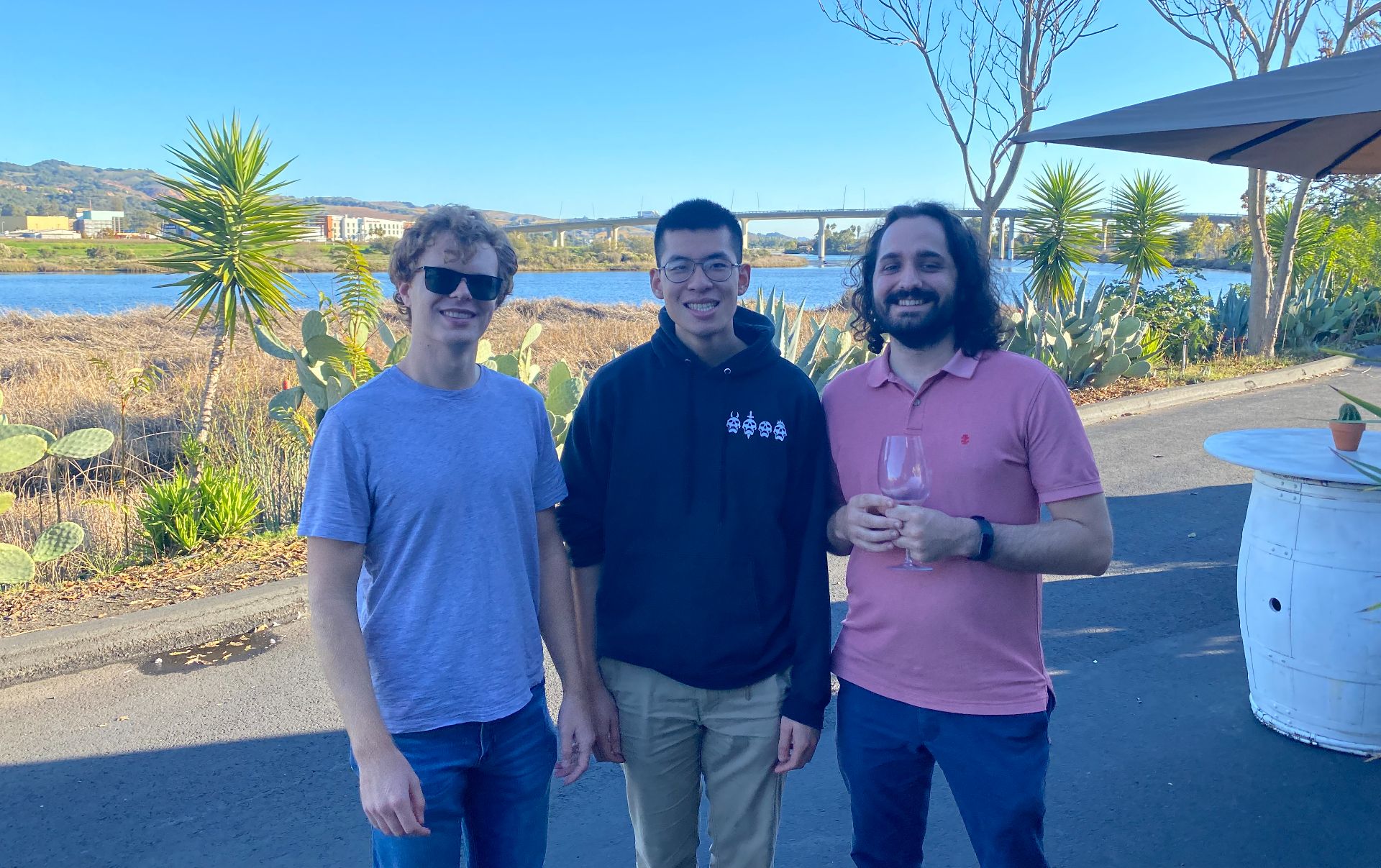
Closing and Converting
I’m thrilled about the opportunity to work with David, Jason, and Jacob, the three engineering interns we hired this year. They’re students at Brown, Georgia Tech, and UC Berkeley, and they’ll all work out of our Bay Area HQ for summer 2022.
Prior to signing our summer interns, we had four candidates who turned down internship offers, meaning our internship “close rate” was less than 50% (3/7). Over the previous three years in business, our engineering intern close rate was 2 out of 3 offers, so in total about half of the candidates who got an internship offer accepted it. Some interesting learnings from the internship offer process:
- Salary: Compensation never came up during the offer process. In contrast to my experience with full-time offers, none of the intern candidates negotiated the salary.
- Decision deadline: Our regular job offers expire within a week, but we were more flexible with internship candidates giving them a 2 week deadline instead. However, we do not have evidence that interns need longer than a week to decide. A few of the intern candidates took two weeks to decline their offer, delaying the process for the candidates, and all of the candidates who accepted their internship offer did so within a week. Next year, I plan to stand firm on the one-week decision deadline.
- Location: Since we asked our junior employees (including interns) to work locally one day a week, our interns can’t work remotely and need to live in SF for the summer. This was a perk for some and an obstacle for others; two candidates turned down the offer specifically because they wanted to live on the East Coast. Next year, we will make it clear in the job description that relocation to San Francisco is required.
- Housing: Nearly every candidate asked about housing in San Francisco; this year, 2/7 candidates we made offers to asked about a housing stipend and 3/7 asked for introductions to the others summer interns for roommates. In the future, we may consider securing and subsidizing housing for interns that come out of state.
After signing: If you recruit summer interns in the previous fall and winter, there's a long period between their acceptance and their start date. Startups should be sure to communicate with the candidate in the intervening months so that they can keep the relationship warm and nudge their interns to prepare for the summer. At Kapwing, we set up a meeting between the intern and the hiring manager one month from the start date, and our People Ops Lead and I regularly follow up before that.
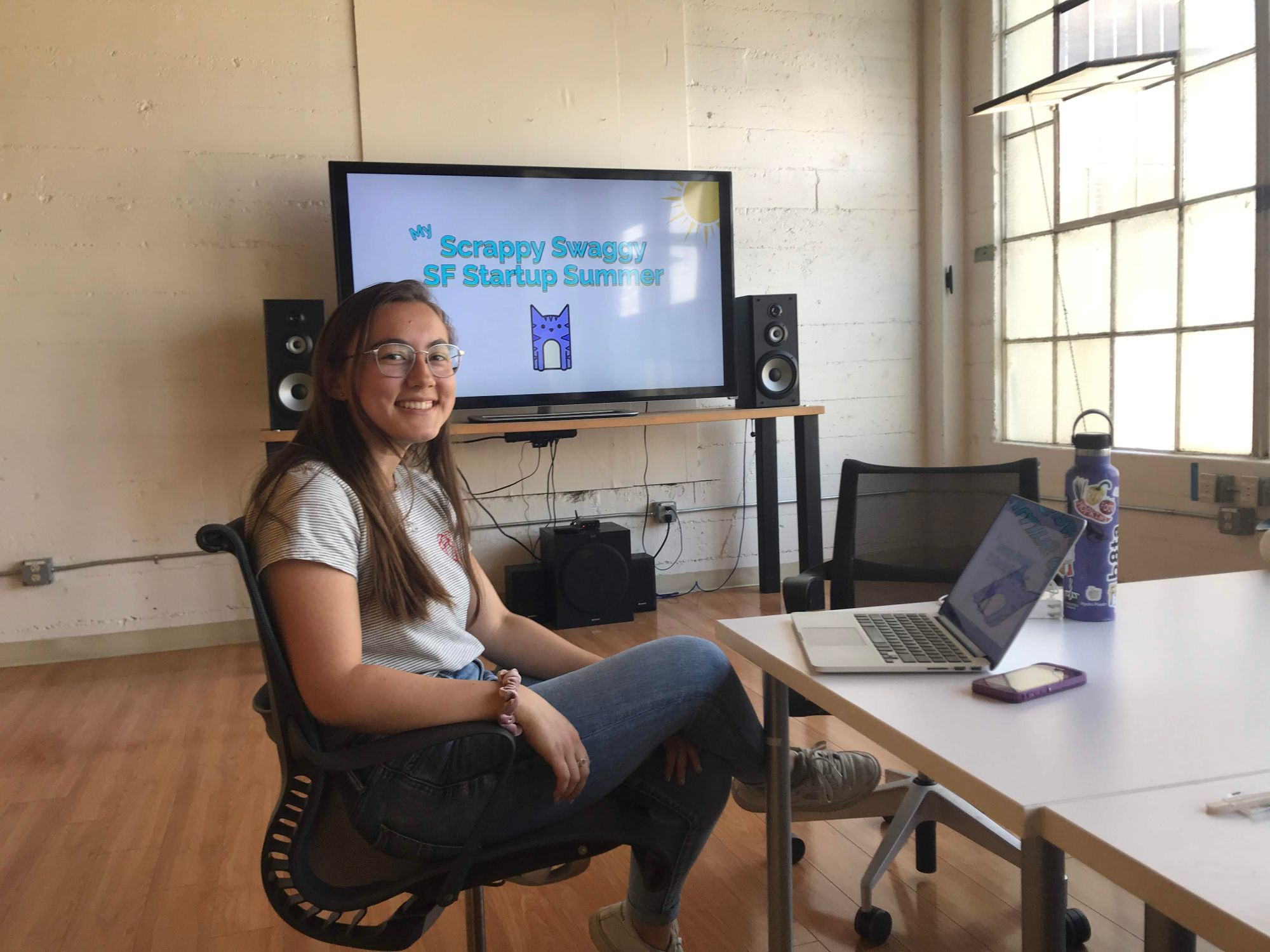
Conversion: Ultimately, the goal of an internship is to bring on great full-time employees. We tell our interns this and prepare them for the “return offer” decision all summer, then make them an offer (or not) in person before they leave. Of the 6 students who interned at Kapwing (technical and non-technical) in the last three years, we made 3 full-time offers and converted 2 to full-time. One of those people was Grace, our incredible Associate Product Marketing Manager who now serves as the outward face of Kapwing.
Onboarding: Since interns tend to have less social support when they’re away from school, we’ll have dedicated events for connecting with the interns for our whole team over the summer. We will give them a project area where they can make a significant impact during their short employment and a starter project dedicated to helping them ramp up in their first couple of weeks. Hopefully, we can give our interns an amazing summer and convince them to come back when they graduate (or even drop out and get started ASAP).
Conclusion
Internships can be amazing life experience for a college student. My own internships were transformational: I learned a tremendous amount about myself; grew as a professional; explored companies, cities, and career aspirations; and met lifelong friends and colleagues.
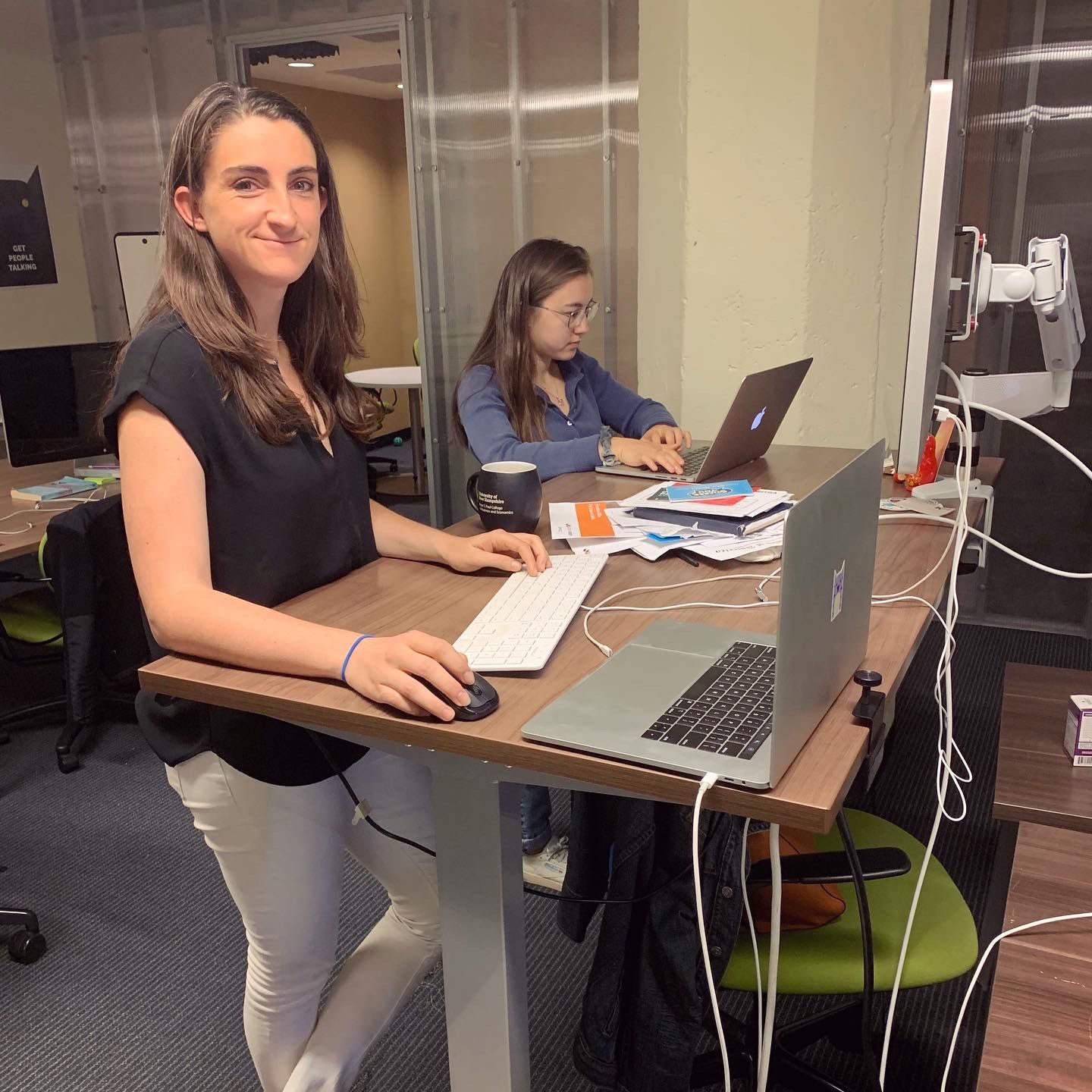
Tech is unique in that even young programmers can add tremendous value, meaning that finding the right intern can make a big difference on engineering velocity. Derrick, our SWE intern of this year, actually won our bug bash, beating out engineers with ten times the seniority. Interns also bring new energy and enthusiasm to your organization, and internships serve as a short-term low-risk experimentation box for new managers and new projects.What it Takes to Hire SWE Interns at a Startup






